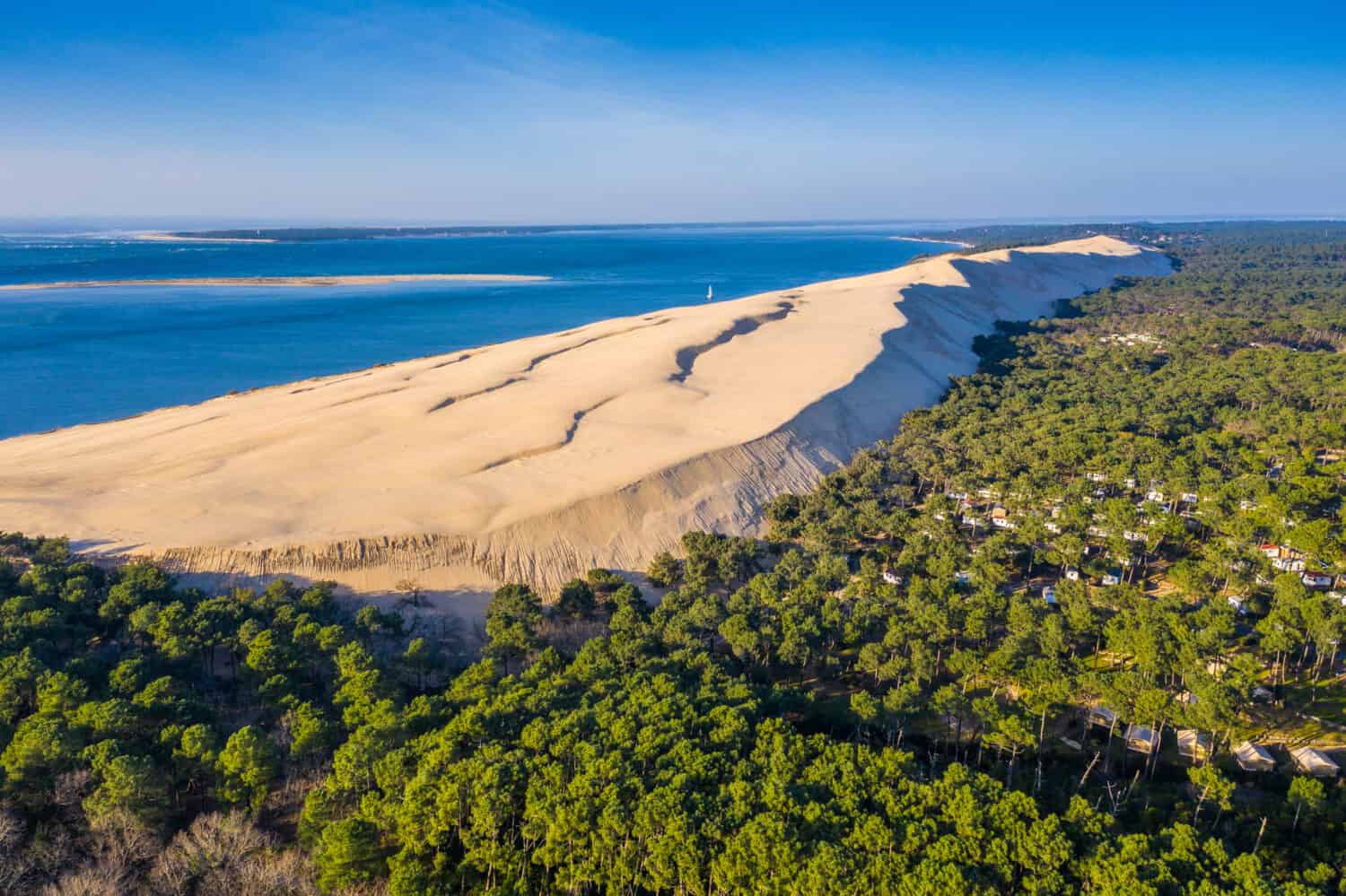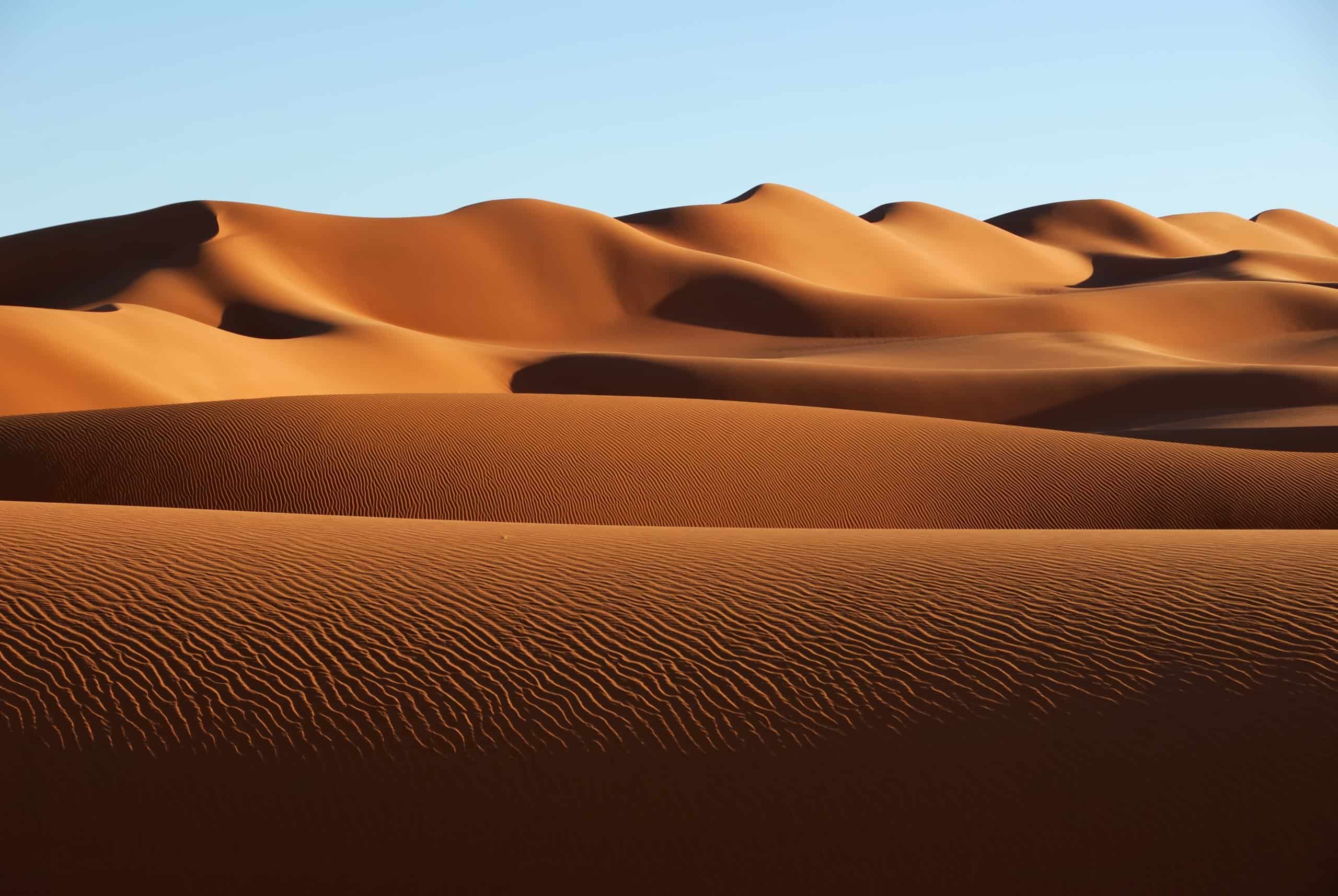Sand dunes exist in all continents and climates, even in Antarctica. You might think the highest dune is in the stunning Sahara Desert, but it is actually in the beautiful country of Argentina!
Keep reading to discover more.
What Is a Sand Dune?

Dunes can be a few hundred years to thousands of years old.
©Lucas Cometto/iStock via Getty Images
A sand dune is a natural landform created when the wind deposits particles of sand on top of each other at the same location. Dunes typically form in areas with a good supply of loose sand, and they are a common feature in deserts, coastal regions, and some inland areas. Sand dunes come in various shapes and sizes and play essential roles in ecosystems and geology.
Sand dunes are not static; they can migrate and change shape over time due to the movement of sand by wind. This process is called aeolian transport.
They support unique ecosystems, with specialized plant and animal species adapted to the harsh conditions. Plus, they provide valuable information about past climate conditions and wind patterns when studied as geological features. Fossilized dunes, known as eolianites, can offer insights into ancient landscapes.
What Is the Tallest Sand Dune on the Planet?

The valley has a lot of sand hills in addition to Duna Federico Kirbus.
©Juan Costanzi/Shutterstock.com
Argentina is home to the tallest sand dune in the world, Duna Federico Kirbus. Located in the northwest of Argentina, in the Catamarca Province, it has a height of 4,035 feet (1,230 meters). At its summit, the dune is 9,334 feet (2,845 meters) above sea level.
Here are some size comparisons:
- Duna Federico Kirbus is taller than the highest point of 53 United Nations-recognized sovereign states.
- It is also only 378 feet (115 meters) shorter than Ben Nevis, the tallest mountain in the United Kingdom (Scotland).
- This dune is taller than the Burj Khalifa — 2,722 feet (829.8 meters) — the tallest building in the world.
- Additionally, Duna Federico Kirbus would still be taller than three Eiffel Towers if placed on top of one another.
The dune is part of the Bolsón de Fiambalá, a semicircular sand valley full of sand hills. It is so tall that the dune is sometimes mistaken as a mountain, especially as the valley is surrounded by many. Its name comes from Argentinian journalist and researcher Federico Kirbus, who discovered its actual height.
Like all the sand dunes in the world, Duna Federico Kirbus is perfect for activities like sandboarding, hiking, or photography. It is also an incredible place to admire the stars and the Milky Way.
What Are the Different Types of Dunes?

The Dune du Pilat, in France, is Europe’s tallest sand dune.
©Stanislav Simonyan/Shutterstock.com
Sand dunes can have various shapes and sizes, depending on environmental conditions and factors such as wind direction and strength. Common types of dunes include:
Barchan Dunes
Crescent-shaped dunes with their tips pointing downwind. They often have a gentle windward slope and a steeper slip face on the downwind side. These dunes typically form in areas with limited sand supply and constant wind direction.
Coastal Dunes
Coastal dunes form along coastlines and are influenced by the interaction between wind and water. They help protect coastal areas from erosion and storm surges. Coastal dunes can take on various shapes and sizes, including foredunes (closest to the beach) and backdunes (further inland). The Namib Desert in Namibia, and the Dune du Pilat in France are famous examples.
Dome Dunes
Also known as “coppice dunes” or “oblong dunes,” these are typically isolated and oval-shaped. They have gentle slopes on all sides and are often found in deserts with a moderate sand supply. These dunes can grow in size over time.
Draa Dunes
Draa dunes are long, sinuous dunes that resemble a series of waves. They often form in areas with complex wind patterns and can have a serpentine appearance.
Linear Dunes
Linear dunes are elongated ridges of sand that can stretch for long distances. They are often in regions with solid and consistent winds, such as some desert environments. Linear dunes can have various shapes and orientations.
Parabolic Dunes
Similar to barchan dunes but with their tips pointing upwind. They typically form in areas with some vegetation that helps anchor the sand.
Star Dunes
Star dunes are complex, multi-lobed dunes with multiple arms radiating from a central point. They do not have a dominant wind direction and can form in areas with variable wind patterns. Star dunes can be pretty tall and exhibit intricate shapes.
Seif Dunes
Seif dunes are long, straight dunes that resemble the blade of a scimitar or a sword. They form in areas with strong, consistent winds, such as desert regions. Seif dunes can merge and change shape over time.
Transverse Dunes
Long, parallel ridges of sand oriented perpendicular to the prevailing wind direction. They can be of significant size and in areas with abundant sand and consistent winds.
Thank you for reading! Have some feedback for us? Contact the AZ Animals editorial team.








